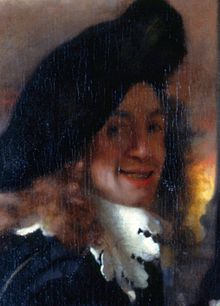
Back Johannes Vermeer Afrikaans Jan Vermeer ALS Johannes Vermeer AN يوهانس فيرمير Arabic يوهانيس ڤيرمير ARY جوهانس فيرمير ARZ Johannes Vermeer AST Johannes Vermeer AVK Yan Vermeer Azerbaijani Ян Вермеер Bashkir
Johannes Vermeer | |
|---|---|
 | |
| Born | Joannis Vermeer baptised 31 October 1632 |
| Died | 15 December 1675 (aged 43) Delft, County of Holland, Dutch Republic |
| Known for | Painting |
| Notable work | 34 works universally attributed[2] |
| Movement | Dutch Golden Age Baroque |
| Spouse | Catharina Bolnes |
| Signature | |
 | |
Johannes Vermeer (/vərˈmɪər, vərˈmɛər/, Dutch: [vərˈmeːr], see below; also known as Jan Vermeer; October 1632 – 15 December 1675) was a Dutch Baroque Period[3] painter who specialized in domestic interior scenes of middle-class life. He is considered one of the greatest painters of the Dutch Golden Age. During his lifetime, he was a moderately successful provincial genre painter, recognized in Delft and The Hague. He produced relatively few paintings, primarily earning his living as an art dealer. He was not wealthy; at his death, his wife was left in debt.[4]
Vermeer worked slowly and with great care, and frequently used very expensive pigments. He is particularly renowned for making masterful use of light in his work.[5] "Almost all his paintings", Hans Koningsberger wrote, "are apparently set in two smallish rooms in his house in Delft; they show the same furniture and decorations in various arrangements and they often portray the same people, mostly women."[6]
The modest celebrity he enjoyed during his life gave way to obscurity after his death. He was barely mentioned in Arnold Houbraken's major source book on 17th-century Dutch painting (Grand Theatre of Dutch Painters and Women Artists, published 1718) and, as a result, was omitted from subsequent surveys of Dutch art for nearly two centuries.[7][a] In the 19th century, Vermeer was rediscovered by Gustav Friedrich Waagen and Théophile Thoré-Bürger, who published an essay attributing 66 pictures to him, although only 34 paintings are universally attributed to him today.[2] Since that time, Vermeer's reputation has grown enormously.
- ^ Boone, Jon. "The Procuress: Evidence for a Vermeer Self-Portrait". Essential Vermeer. Retrieved 13 September 2010.
- ^ a b Janson, Jonathan. "Complete Vermeer Catalogue & Tracker". Essential Vermeer. Retrieved 16 June 2010.
- ^ Courtney, Jennifer; Sanford, Courtney (2018). Marvelous To Behold. Classical Conversations. ISBN 978-0-9995748-4-3.
- ^ Cite error: The named reference
Bulfinchwas invoked but never defined (see the help page). - ^ Cite error: The named reference
Wadumwas invoked but never defined (see the help page). - ^ Koningsberger, Hans (1977). The World of Vermeer. New York: Time-Life Books. OCLC 755281576.
- ^ Barker, Emma; et al. (1999). The Changing Status of the Artist. New Haven: Yale University Press. p. 199. ISBN 0-300-07740-8.
- ^ Blankert, Albert (2007). "Vermeer and his Public". In Blankert, Albert; Montias, John Michael; Aillaud, Gilles (eds.). Vermeer. New York: Overlook. p. 164. ISBN 978-1-58567-979-9.
Cite error: There are <ref group=lower-alpha> tags or {{efn}} templates on this page, but the references will not show without a {{reflist|group=lower-alpha}} template or {{notelist}} template (see the help page).
© MMXXIII Rich X Search. We shall prevail. All rights reserved. Rich X Search